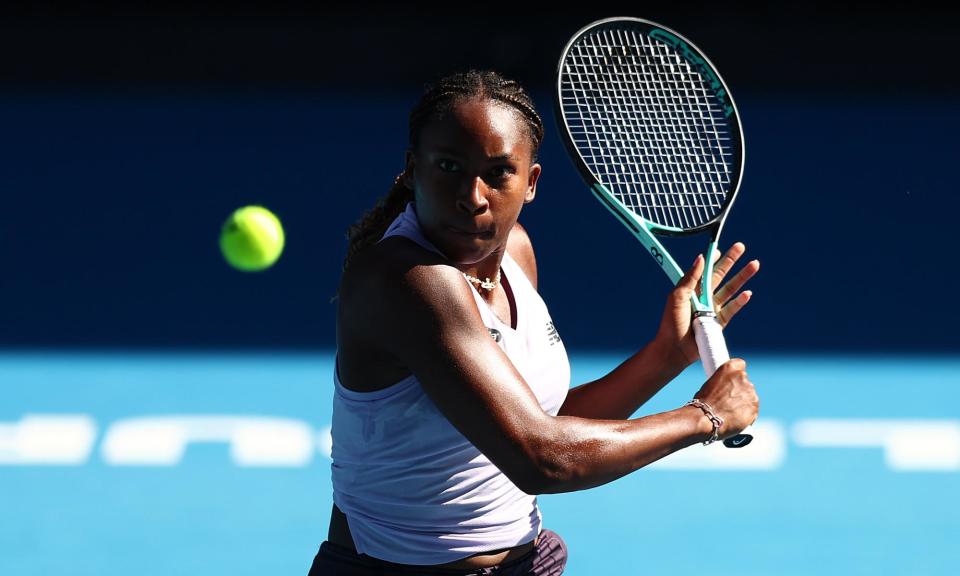Australian Open: can Coco Gauff back up New York glory at Melbourne Park?

When Coco Gauff claimed her maiden grand slam title at the US Open this past September it was decidedly not an unexpected outcome. After all, Gauff, still only 19, had been touted as the next great American woman tennis player for several years, having been the top ranked junior in the world in 2018. And with her extraordinary athleticism, lethal serve and on-court discipline, it seemed destined that she would fulfill her huge promise at a young age.
But the question of whether her Open victory will serve as an immediate springboard into a run of slam dominance is another matter altogether. While it’s conceivable that Gauff can join world No 1 Iga Świątek as a threat at every slam she plays, it’s instructive to recall that many prolific champions of the Open era – both men and women – didn’t string together a bunch of major titles right away.
Sure, there have been prolific champions who, once winning their first slam never looked back – Jimmy Connors, Chris Evert, Björn Borg, Martina Navratilova, John McEnroe and Steffi Graf all come to mind. But, more often than not, it has taken some time to become a dominant force at the biggest events.
One need look no further than Gauff’s childhood idol, Serena Williams. Williams, who was the last American teenager to win the US Open before Gauff’s triumph, struggled in the big events immediately after her shocking Open win over her sister Venus in 1999. It took Serena nearly three years for her to notch her second major title, on the clay at the 2002 French Open – which, ironically, was Serena’s worst surface. Of course, from that point on, Serena dominated at the majors, never going consecutive seasons without a slam through 2017, and is now considered, along with Helen Wills Moody, Graf, and Navratilova, in the conversation of the greatest women’s player of all time.
When Pete Sampras exploded onto the scene at the US Open in 1990 at 19 years old, he was the unheralded 12th seed and, outside from the most passionate tennis fans at the time, barely known to the viewing public. But he became a household name in short order as he unleashed a never-before-seen display of powerful serving backed up by an incandescent style of all-court tennis en route to the title where he took out Ivan Lendl, McEnroe and Andre Agassi. But Sampras struggled with his desire and found it difficult to rediscover the magic of that initial Open triumph in the years immediately after. Yet it all came together once again at Wimbledon in 1993 and he’d go on to win 13 major titles over the next 10 years. And after he retired, it appeared that no man would come close to eclipsing his record haul of 14 slams … but it just so happened Big Three of Federer, Nadal and Novak Djokovic were ready to take the reins from Sampras right away.
Speaking of the Big Three, while it’s literally impossible to conceive of him struggling to win the big titles now, Djokovic also had his share of slam futility after his first major triumph, at the 2008 Australian Open when he was 20 years old. Djokovic, who at the time was known for lacking stamina in the most stressful moments against the best players, was thoroughly dominated by his great rivals Federer and Nadal early on. But three years after winning in Melbourne in 2008, Djokovic secured his second slam crown at the 2011 Australian Open, and he has been as dominant a force as the sport has ever seen, accumulating 23 majors since that first victory in Australia 16 years ago. Although they possess vastly different games, Djokovic’s case is similar to that of Sampras as they both had to find that balance of raw talent to go along with mental and emotional toughness.
There’s no question that Gauff has the varied tools to compile a career slam haul in the double digits; her extraordinarily powerful first serve, laser-like backhand, sprinter-like speed and intelligent shotmaking –and, not to be overlooked, her close family and grounded personality. Her support system has obviously been a huge help in helping Gauff avoid some of the common roadblocks – eg burnout – that so often accompany young stardom.
The big “if” for Gauff has always been her forehand, which she hits with an extreme western grip and is prone to errors. But, like most champions, stubbornness is an essential personality trait and as long as Gauff is winning, don’t expect her to tweak her forehand too significantly.
Of course, the not-so-wild card that Gauff possesses is her coach: Brad Gilbert. Having worked together only a short time before her New York triumph, it’s clear that Gilbert has instilled in Gauff a higher level of confidence that was previously missing. This is something that Gilbert also accomplished with Andre Agassi, Andy Roddick and Andy Murray.
Gauff looks poised to make a solid run at consecutive slam titles when the Australian Open commences on Monday morning in Melbourne (Sunday evening in the United States). With her first ever title defense in Auckland this past weekend, she is playing into form at just the right time. It’d be to the benefit of tennis fans if Gauff and Świątek end up on opposite sides of the draw, with a chance to meet in the final. And with it, perhaps kick-start what would be a much-needed rivalry in women’s tennis.

 Yahoo Sport
Yahoo Sport 





































